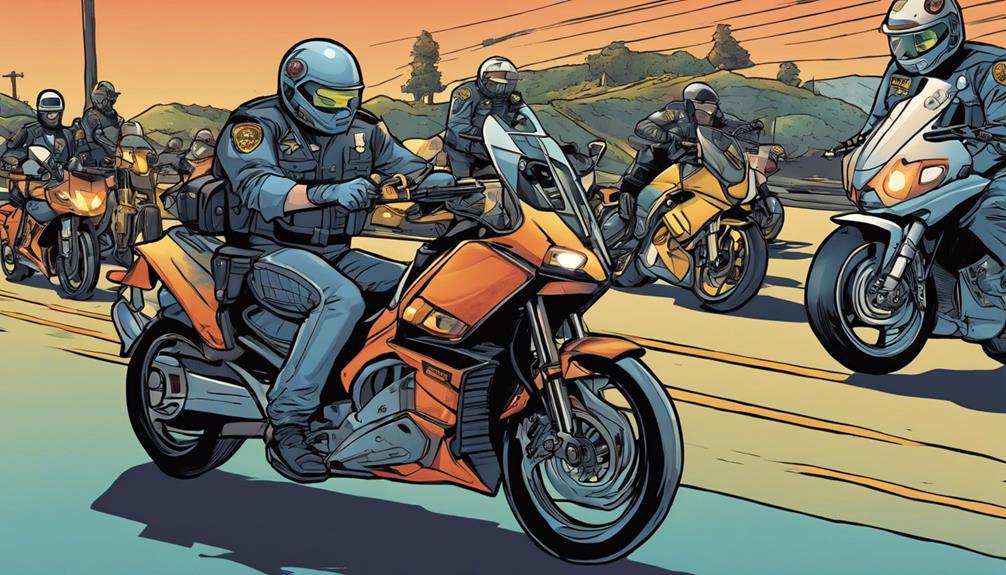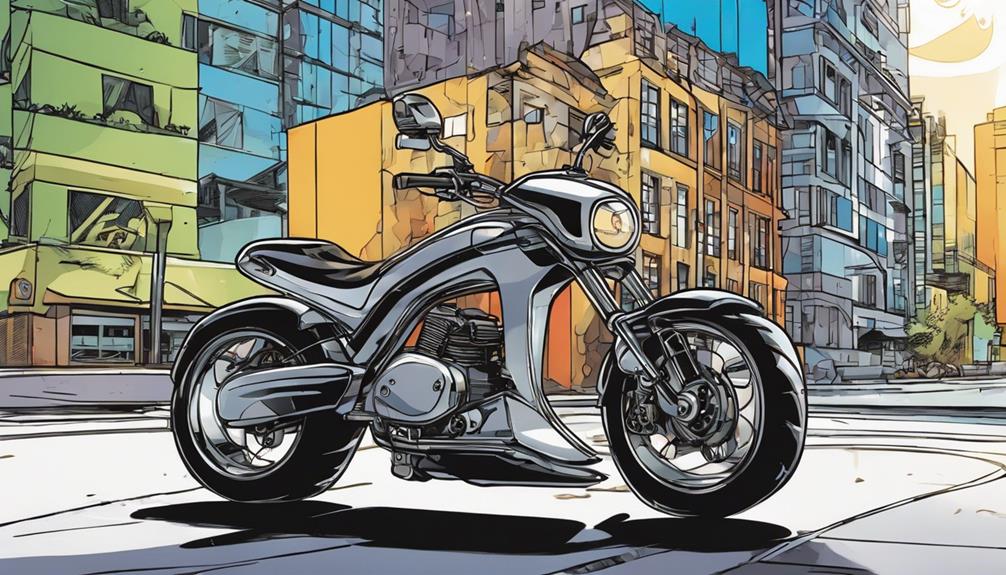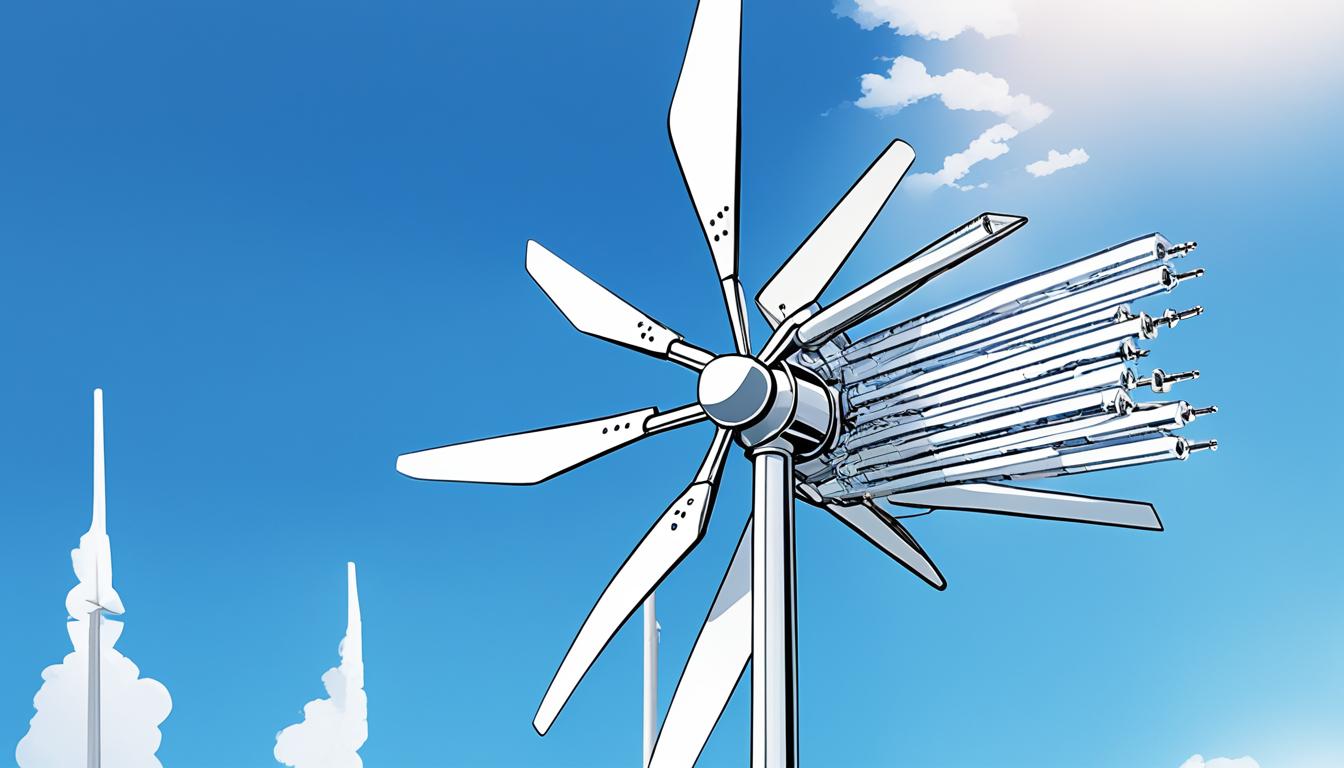When zipping around California on your electric motorcycle, know the laws to ride safely and legally. Classifications like Class 1 and Class 3 matter, as do age requirements and speed limits. Always wear your helmet—it's mandatory. Stick to traffic laws, and consider taking a safety course. Stay defensive on the road. Electric motorcycle laws are constantly evolving, so stay tuned for updates and advancements. It's important to promote responsible riding and prepare for changes in technology to comply with regulations.
Key Takeaways
- California distinguishes Class 1 and Class 3 electric motorcycles with specific speed limitations and operational criteria.
- Riders must comply with age requirements, mandatory helmet use, and adhere to speed limits.
- Enforcement of speed and power restrictions is in place with penalties for violations.
- Safety tips include helmet maintenance, adherence to traffic laws, and completion of safety courses.
- Future laws may evolve to align with technological advancements and promote responsible riding behaviors.
California Electric Motorcycle Classifications
In California, electric motorcycles are categorized into different classes based on speed assistance and motor operation.
Class 1 electric motorcycles offer pedal assistance up to 20 mph, while Class 3 models provide pedal assistance up to 28 mph.
For Class 3 electric motorcycles in California, riders must be at least 16 years old to operate the vehicle legally.
These electric motorcycles must adhere to specific speed limitations and operational criteria according to their classification.
Manufacturers of electric motorcycles in California are required to label their bikes with information on classification, top speed, and motor power wattage.
This classification system guarantees that riders are aware of the capabilities and restrictions of their electric motorcycles, promoting safety and compliance with California's regulations.
Make sure to check the classification of your electric motorcycle before hitting the road to confirm you're following the proper guidelines set forth by the state.
Age and Registration Requirements

You must be at least 16 years old to ride electric motorcycles legally in California.
Unlike traditional motor vehicles, electric motorcycles don't need to be registered in the state.
Following age requirements and understanding registration exemptions are essential for complying with California's electric motorcycle laws.
Age Requirements
When riding Class 3 electric bikes in California, age requirements dictate that riders must be at least 16 years old.
These California regulations aim to guarantee the safety of e-bike riders, especially when operating higher-speed e-bikes.
The age compliance for Class 3 electric bikes, which can reach speeds up to 28 mph, is essential in preventing accidents on the road.
While electric bike riders in California aren't required to have a driver's license or vehicle registration, it's vital to adhere to the specific age restrictions for Class 3 e-bikes.
By incorporating age requirements into the electric bike laws, California emphasizes safety and promotes responsible riding practices.
Registration Process
Frequently, riders of electric motorcycles in California must be at least 16 years old to legally operate these vehicles. When it comes to the registration process for electric motorcycles in California, there are some unique aspects worth noting. Unlike traditional gasoline-powered motorcycles, electric motorcycles are exempt from vehicle registration requirements in California. Additionally, operators of electric motorcycles in California are not obliged to obtain a driver's license to ride these vehicles legally. The registration process for electric motorcycles in California is straightforward, with no specific age restrictions for riders. This means that as long as you meet the minimum age requirement of 16 years old, you can enjoy the benefits of riding an electric motorcycle in California without the need for registration or specific age requirements.
| California Electric Motorcycle Registration | Requirements |
|---|---|
| Age of Riders | 16 years or older |
| Vehicle Registration | Exempt |
| Driver's License | Not required |
| Legal Requirements | Minimal |
Legal Obligations
Understanding the legal obligations concerning age and registration requirements is vital for operating electric motorcycles in California. In California, riders of electric motorcycles must be at least 16 years old to comply with the age restrictions for lawful operation.
While electric motorcycles don't require registration in the state, riders must still adhere to helmet laws for safety compliance. It's essential for riders to be aware of these operating regulations and rider responsibilities to guarantee lawful and safe operation of electric motorcycles in California.
Safety Regulations and Violations

You must always wear a helmet while riding your electric bike in California to stay safe on the road. Remember to comply with the maximum speed limit of 20 mph to avoid penalties and fines.
Ensuring helmet enforcement and speed limit compliance is essential for your safety and legal adherence.
Helmet Requirement Enforcement
Enforcing mandatory helmet use for electric motorcycle riders in California is important for ensuring road safety and reducing the risk of head injuries. California mandates that all riders wear helmets while operating electric motorcycles to protect them in case of accidents. Failure to comply with this regulation can lead to fines and penalties.
The enforcement of helmet requirements is a critical aspect of promoting safe riding practices and minimizing the severity of injuries sustained in collisions. By strictly enforcing helmet laws, California aims to safeguard riders and prevent life-threatening head injuries. Adhering to these regulations isn't only a legal obligation but also a fundamental step towards ensuring the well-being of electric motorcycle riders on the road.
Speed Limit Compliance
Following California's 20 mph speed limit for electric bicycles is vital to adhere to state safety regulations and avoid penalties. California law requires that electric bicycles mustn't exceed 20 mph to guarantee road safety and legal compliance. Violating this speed limit can result in fines and penalties, highlighting the significance of abiding by regulations for safe riding.
By enforcing strict speed regulations on electric bicycles, California aims to enhance road safety and prevent violations. It's important for riders to prioritize compliance with the 20 mph speed limit to avoid legal consequences and ensure safe operation of electric bicycles.
Speed and Power Limits Enforcement

To ensure compliance with California's electric motorcycle laws, enforcement agencies actively monitor e-bikes to prevent them from surpassing the designated speed and power limits. California regulations mandate that e-bikes mustn't exceed 20 mph to be considered legal bicycles and that their motors shouldn't go beyond 750 watts.
Adhering to these limits is essential for the proper and lawful operation of electric bicycles in the state. Violations of the speed and power restrictions can result in penalties and fines for riders. It's important for e-bike users to be aware of and follow these regulations to avoid legal consequences.
Enforcement agencies play a crucial role in making sure that e-bike riders comply with the established speed and power limits to promote safety on the roads and prevent misuse of electric bicycles. Stay informed and ride responsibly to enjoy the benefits of electric biking while staying within the boundaries of the law.
Safety Tips for Electric Motorcycle Riders

Always prioritize safety by following these essential tips when riding an electric motorcycle in California.
Start by wearing a DOT-approved helmet to protect your head in case of accidents, as mandated by California laws.
Regularly check and maintain your electric motorcycle's brakes, tires, lights, and signals to guarantee safe operation on the road.
Remember to adhere to all traffic laws and regulations applicable to motor vehicles to avoid fines and guarantee a smooth ride.
Consider taking a motorcycle safety course to enhance your riding skills and deepen your understanding of California laws governing electric motorcycles.
Practice defensive riding by staying alert, anticipating potential hazards, and being proactive in avoiding risks.
Future of Electric Motorcycle Laws

The evolution of electric motorcycle laws in California is shaping a new era of sustainable and innovative transportation regulations. As the popularity of electric motorcycles continues to rise, the state is looking towards the future to accommodate this growing trend.
Infrastructure improvements such as dedicated e-motorcycle lanes are being considered to provide a safer and more efficient environment for electric motorcycle riders. Additionally, rapid technological advancements in electric motorcycles are enhancing their performance and range capabilities, making them a more viable option for daily commuting.
California's focus on promoting clean transportation options is evident through initiatives like incentivizing Zero-Emission Motorcycles (ZEMs) to reduce emissions and improve air quality. The California Air Resources Board (CARB) plays a significant role in shaping the future of electric motorcycle laws by developing new regulations that address the unique characteristics and needs of electric motorcycles.
These upcoming laws aim to support the integration of electric motorcycles into existing transportation frameworks while ensuring safety and sustainability for all road users.
Frequently Asked Questions
Can You Ride Ebikes on the Sidewalk in California?
You can ride e-bikes on California sidewalks, but remember to yield to pedestrians, maintain a safe speed, and use caution. Be considerate, check local regulations, and prioritize pedestrian safety by using signals to alert walkers.
What Is the Law for Electric Motorcycles in California?
You can ride electric motorcycles in California, but not in bike lanes. These zero-emission motorcycles must be registered. CARB classifies them as ZEMs to promote clean transportation. So, remember to follow the rules for a safe ride.
Do You Need to Wear a Helmet on an Electric Bike in California?
Yes, you need to wear a helmet on an electric bike in California. It's mandatory for all riders, regardless of the type of e-bike. Failure to do so can lead to fines and penalties. Stay safe!
Do Electric Bikes Need a License Plate in California?
Do electric bikes need a license plate in California? Nope! California treats electric bikes like regular bicycles, so you can zip around plate-free. Enjoy the ride without worrying about license plate hassles.
Are There Laws or Regulations Regarding Electric Motorcycles and Wind Turbines in California?
In California, there are laws and regulations in place concerning electric motorcycles and wind turbines. One important aspect involves preventing wire twisting on turbines to ensure safe and efficient operation. It’s crucial for all activities related to these technologies to comply with the established guidelines to promote sustainability and safety.
Conclusion
As you cruise down California's winding roads on your electric motorcycle, remember to stay safe and follow the laws. Just like a well-oiled machine, knowing and abiding by the regulations guarantees a smooth ride without any bumps in the road.
So rev up your engine, keep your eyes on the horizon, and enjoy the freedom of the open road while staying within the bounds of the law.
Safe riding, rider!









